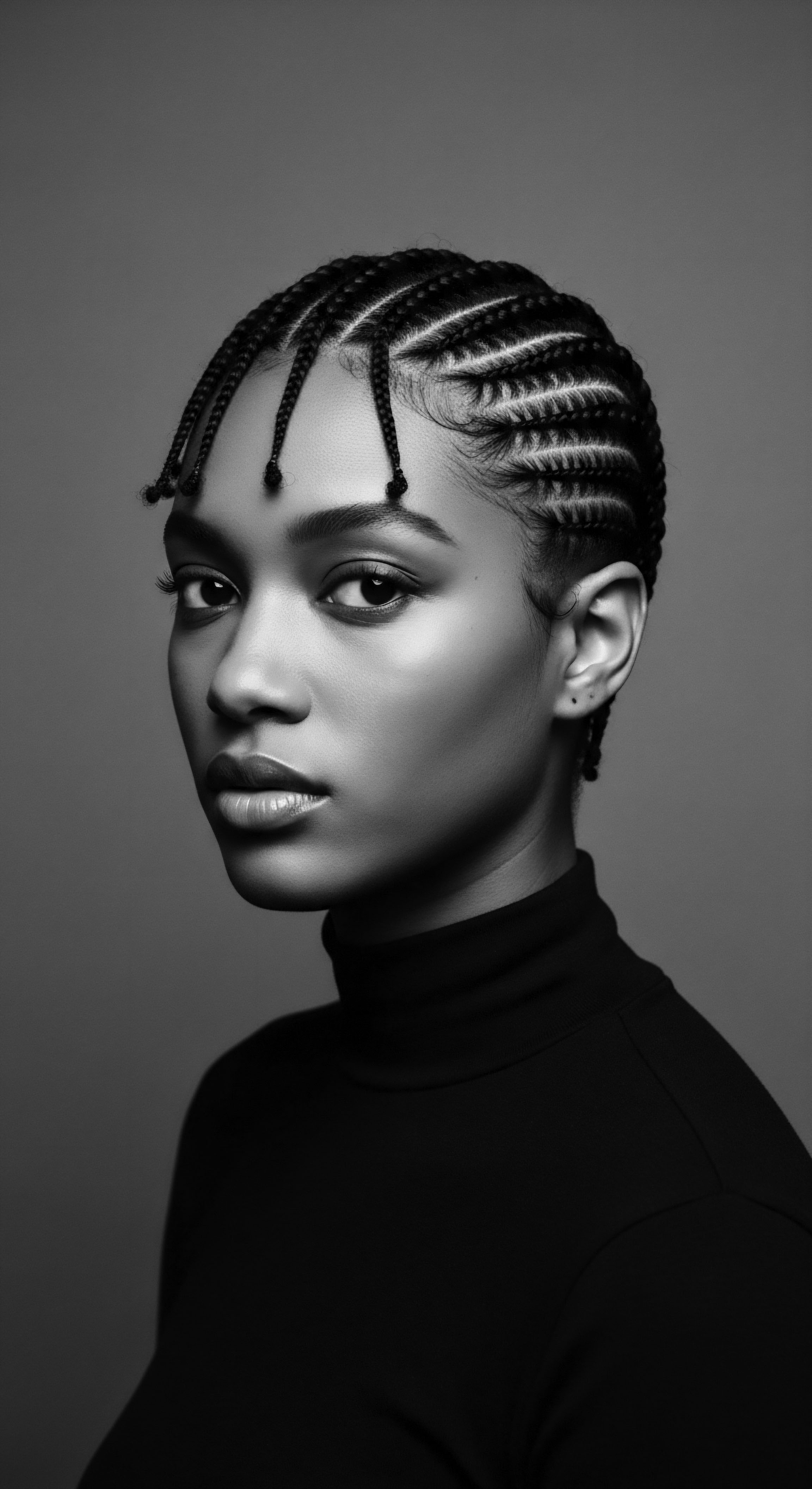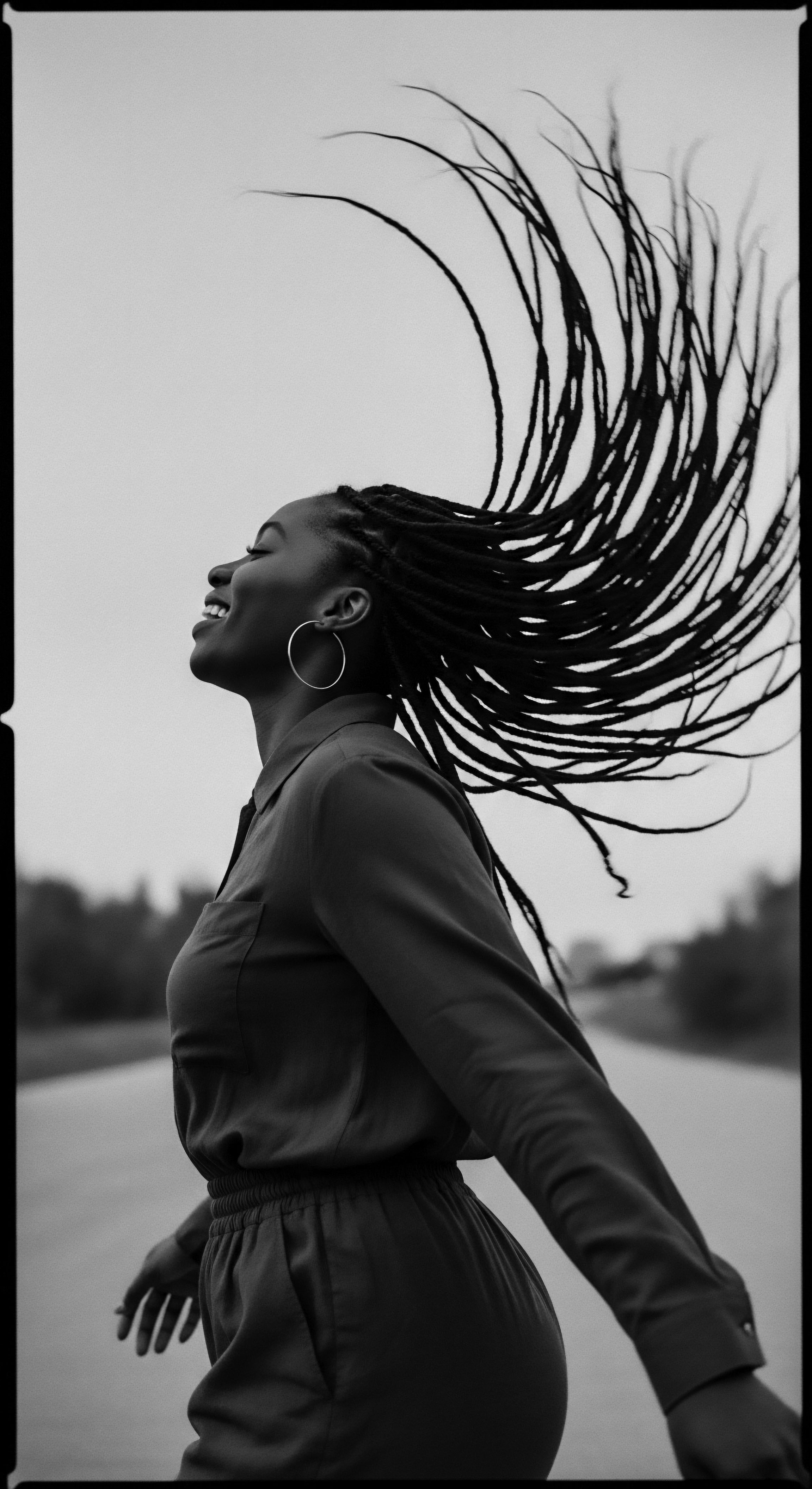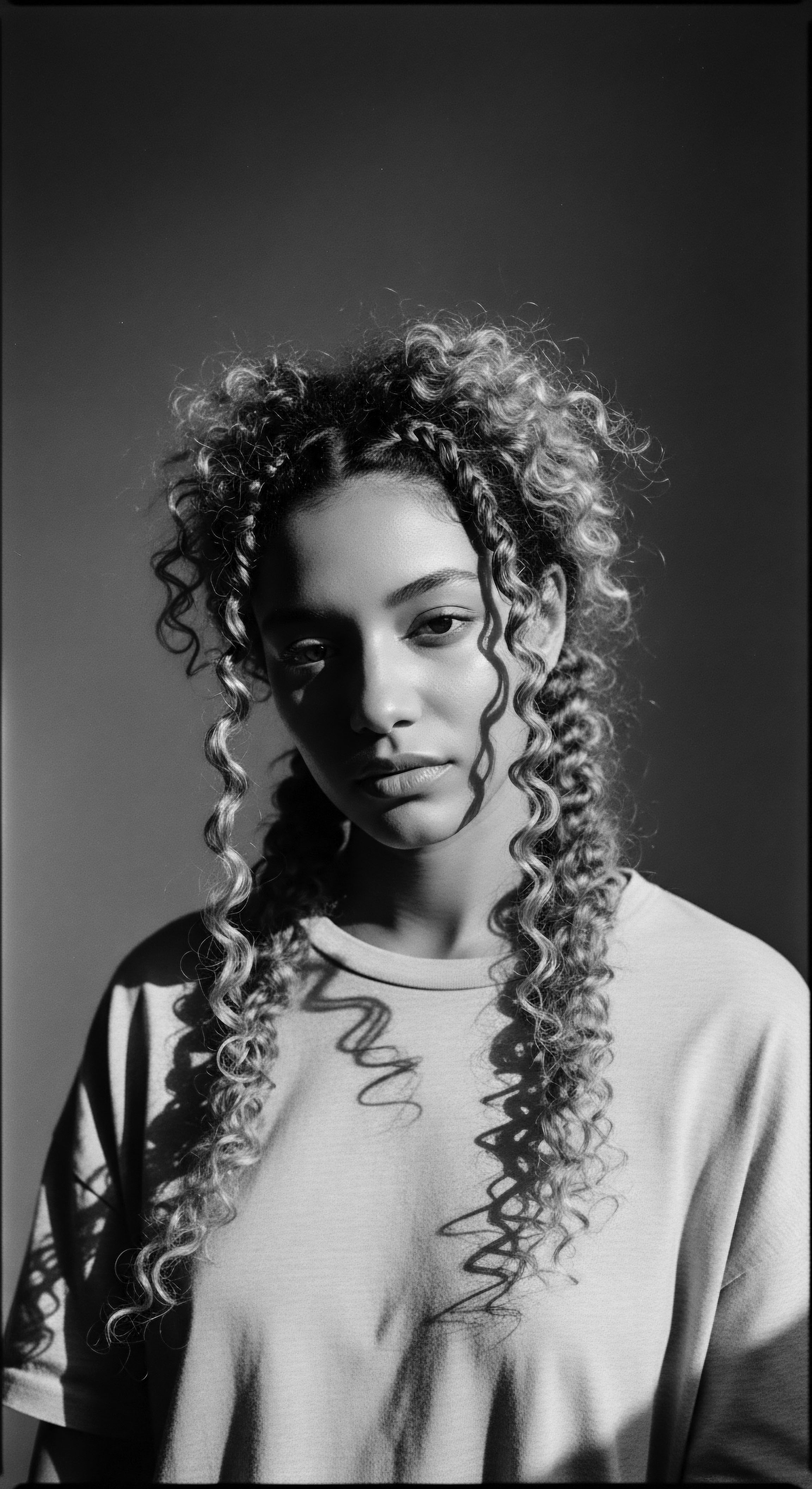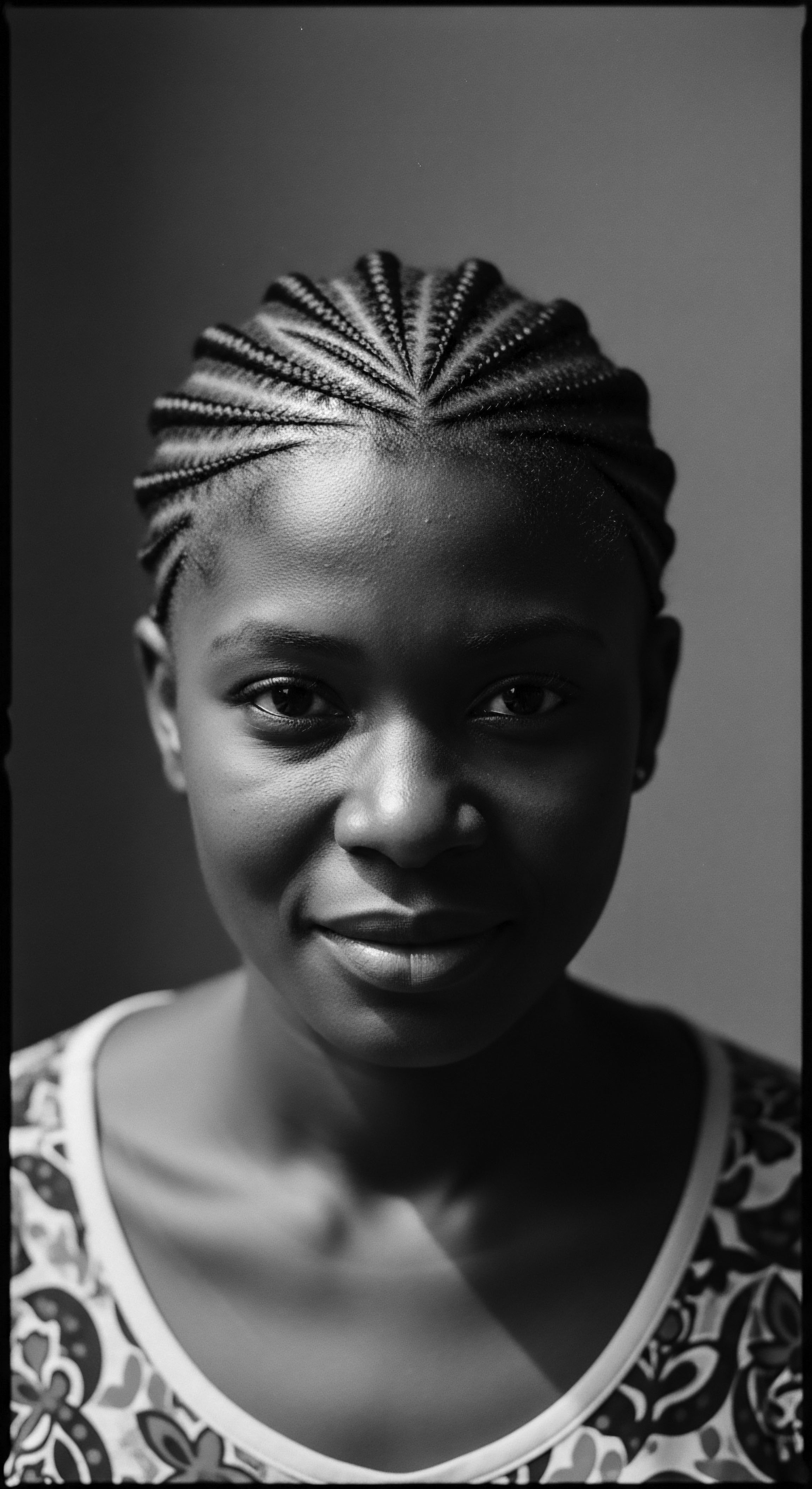
Roots
The very strands that crown us, sculpted by the hands of our ancestors, hold within them a living memory. For those whose lineage traces back to the shores of Africa, textured hair is far more than a biological inheritance; it is a profound archive of resilience, ingenuity, and a defiant spirit. To truly comprehend how cornrows became a silent, yet powerful, instrument in the pursuit of liberty, one must journey back to the elemental understanding of textured hair itself, observing its deep history and the ancestral wisdom woven into its very being.
Across the African continent, long before the shackles of the transatlantic trade, hair served as a vibrant language, a visual lexicon communicating identity, status, and affiliation. It was a canvas upon which stories of lineage, community, age, and even religious belief were told without spoken words. Ancient depictions, like those found in Stone Age paintings on the Tassili Plateau of the Sahara dating back to at least 3000 BC, reveal women adorned with what appear to be cornrows, marking the deep antiquity of this styling practice. In many societies, the care and styling of hair became a communal rite, strengthening social bonds as families gathered to share time and knowledge.
The intricate patterns were not random; they were deliberate statements, reflecting the wearer’s place in the world and their connection to ancestral ways. For instance, in West African societies around the 1400s, a person’s hairstyle could indicate their tribal affiliation, social standing, marital status, wealth, or even their family name.
Textured hair, meticulously styled into cornrows, served as an ancient and living language across African societies, communicating identity and cultural heritage through intricate patterns.
The brutal disruption of the transatlantic slave trade aimed to dismantle this cultural tapestry. Millions of Africans, forcibly removed from their homelands, often faced the dehumanizing act of having their heads shaved upon arrival in the Americas. This barbaric practice sought to strip them of their cultural identity, severing a vital connection to their ancestral heritage and erasing the visual markers of their former lives. Yet, the spirit of resistance, like a persistent root, found ways to endure.
Amidst this profound trauma, the ancestral practice of braiding, particularly cornrows, quietly resurfaced as a small yet significant act of rebellion. It became a means for enslaved Africans to cling to their heritage, to retain a piece of themselves, and to resist the forced cultural erasure imposed by their captors.
The resilience of textured hair, with its natural curl patterns and ability to hold intricate designs close to the scalp, was inherently suited for this quiet defiance. Unlike straighter textures, which might struggle to maintain such defined, long-lasting patterns, coily and kinky hair naturally locks into place, holding styles for weeks. This biological reality, often weaponized against enslaved people through derogatory descriptions of their hair as “unruly” or “nappy” by colonialists, became an unwitting ally in their struggle for liberation. The very qualities deemed undesirable by oppressors allowed for the subtle continuation of deeply rooted hair traditions, transforming what was seen as a mark of difference into a clandestine tool of survival.

The Language of Adornment in Pre-Colonial Times
Before the era of forced displacement, hair traditions in Africa were deeply integrated into daily life and spiritual practices. The styling of hair was not merely for aesthetic appeal; it was a sophisticated system of communication that conveyed complex social data. Different ethnic groups, from the Yoruba to the Wolof, had distinct braiding techniques and patterns, each carrying specific cultural and spiritual meanings.
The choice of style could signify a person’s age, whether they were married or single, their social standing, or even their readiness for certain rites of passage. These styles often involved intricate geometric or curvilinear designs, which were carefully maintained and passed down through generations.
- Social Rank ❉ Elaborate hairstyles or specific adornments often denoted leadership or a high position within the community.
- Marital Status ❉ Certain styles indicated if a woman was single, married, or widowed, allowing for quick recognition within and beyond their immediate group.
- Tribal Affiliation ❉ Distinctive patterns were unique to particular tribes, serving as a visual identifier of one’s ethnic origin.

From Cultural Practice to Forced Erasure
When Africans were captured and transported across the Atlantic, one of the first acts of dehumanization was often the shaving of their heads. This act was designed to strip them of their identity, to sever their connection to their heritage, and to render them anonymous in the eyes of their enslavers. It was a deliberate attempt to break their spirit and assimilate them into a system that denied their humanity. However, the deeply ingrained cultural significance of hair meant that for many, even in the face of such brutality, the memory of these practices persisted.
The forced labor in harsh conditions also meant that simple, practical hairstyles were needed. Cornrows, with their ability to keep hair tidy and protected, offered a solution that inadvertently allowed for the clandestine preservation of a cherished cultural practice. They became a silent act of defiance, a way to hold onto a fragment of self in a world designed to erase it.

Ritual
The ritual of hair braiding, once a celebratory social gathering in ancestral lands, transformed under the brutal reality of enslavement into a clandestine council, a whispered strategizing session. Within the confines of plantation life, where literacy was forbidden and overt communication carried severe penalties, cornrows became an ingenious system of covert messaging. The meticulous patterns, deeply rooted in African aesthetic traditions, took on a dual purpose ❉ adorning the wearer while simultaneously carrying vital information.
The strategic application of cornrow patterns became a silent language for those seeking freedom. Specific designs, woven tightly against the scalp, served as literal maps, directing escapees along paths to liberty. A particular number of braids might indicate possible escape routes, while curved braids could represent winding roads or rivers. This covert communication bypassed the scrutiny of overseers who, unfamiliar with the nuanced language of African hair, would see only a neat, practical hairstyle.
One such pattern, known as the “departes” style in Colombia, featured thick, tight braids tied into buns on top, signaling the intent to escape. Curved braids, distinctively sculpted against the scalp, would represent the actual roads or paths to follow.
Cornrows became silent blueprints of freedom, their patterns guiding escapees along hidden routes and communicating coded messages within plain sight.
Beyond cartography, cornrows served as mobile pantries. Enslaved women, with remarkable foresight and bravery, would hide rice seeds, grains, or even gold fragments within the tight braids of their hair. These concealed provisions offered a lifeline during perilous journeys to freedom, providing sustenance when no other food source was available.
This practice was a direct link to the ancestral knowledge of agricultural survival, an act of ethnobotanical resistance ensuring not just individual survival, but the potential for future self-sufficiency in free communities. The very seeds that fueled their survival were often those deeply intertwined with their African heritage, carried across the Middle Passage within these living vessels of hair.

How Did Hair Patterns Communicate Escape Paths?
The intelligence network woven into cornrows was sophisticated, adapting to the terrain and obstacles of potential escape routes. The topography of a landscape could be mirrored in the lines of braids. A straight line of cornrows might indicate a direct path North, towards regions of relative freedom.
A sinuous braid might represent a river to follow, while a bun or raised section could signify a mountain or a safe haven. These visual instructions were often shared and memorized among trusted individuals, ensuring that the knowledge could be disseminated without the need for written documents, which were often forbidden and dangerous to possess.
One widely documented historical example comes from 17th-century Colombia, where an escaped African King named Benkos Biohó established San Basilio de Palenque, the first free African village in the Americas. Biohó created an intelligence network where women used their cornrows to craft and deliver maps and messages, avoiding detection by Spanish colonizers. This communal effort in braiding sessions became a vital part of their resistance, transforming an intimate act of care into a strategic operation for collective liberation.
The choice of specific patterns and their meanings were likely localized, developing within particular communities or plantations, thereby adding another layer of secrecy. This localized “code” would be unintelligible to outsiders, preserving its effectiveness as a communication method.

Tools of Covert Communication
The tools of this covert communication were minimal, yet deeply significant, relying entirely on the natural attributes of textured hair and the skilled hands of the braiders. No specialized instruments were needed beyond what was readily available, making the practice undetectable.
- Fingers ❉ The primary tools, adept at sectioning, gripping, and interlacing the hair tightly against the scalp.
- Combs (makeshift) ❉ Often crafted from scavenged materials like wood, bone, or even pieces of metal, these aided in parting and smoothing the hair for precise patterns.
- Natural Oils/Fats ❉ Substances like shea butter, coconut oil, or animal fats, applied to the hair and scalp, not only moisturized and protected the hair from harsh conditions but also aided in smoothing the strands for tighter, more defined braids that would hold their shape for extended periods.
| Aspect of Hair Communication Primary Purpose |
| Pre-Colonial African Societies Identity marker, social status, celebration, spirituality. |
| Enslaved Communities Clandestine communication, survival, resistance. |
| Aspect of Hair Communication Information Conveyed |
| Pre-Colonial African Societies Tribal affiliation, age, marital status, wealth. |
| Enslaved Communities Escape routes, timing of meet-ups, presence of obstacles, sustenance. |
| Aspect of Hair Communication Audience |
| Pre-Colonial African Societies Community members, other tribes. |
| Enslaved Communities Fellow enslaved people, trusted allies. |
| Aspect of Hair Communication Risk of Detection |
| Pre-Colonial African Societies Low; a public display of cultural norms. |
| Enslaved Communities High; severe punishment if discovered. |
| Aspect of Hair Communication Concealed Items |
| Pre-Colonial African Societies Adornments like beads, shells, gold. |
| Enslaved Communities Seeds, gold nuggets, small tools. |
| Aspect of Hair Communication The fundamental communicative nature of hair transformed under oppression, becoming a strategic tool for liberation while maintaining its deep cultural resonance. |

Relay
The legacy of cornrows extends beyond mere patterns on the scalp; it represents a profound relay of knowledge, a silent testament to human spirit defying its chains, passed through generations. The survival strategies embedded in cornrows during slavery demonstrate a remarkable synergy of ancestral wisdom, communal solidarity, and a sophisticated understanding of their environment. This was not a superficial act; it was a deep, sustained effort to preserve life and cultural continuity against overwhelming odds. The physical act of braiding, often carried out by women, also served as a moment for oral tradition to flourish, for stories of hope and plans for freedom to be shared quietly among those who understood the language of their hair.
Consider the astonishing case of the Maroon communities in Suriname and French Guiana. These were societies built by people who had escaped slavery, establishing autonomous settlements in the rainforests. Oral histories within these communities speak of enslaved women who, during their flight to freedom, hid rice seeds within their cornrows.
These were not just any seeds; they included varieties like African rice (Oryza glaberrima), a staple crop in West Africa. Upon reaching their new, hidden homes, these women planted the concealed grains, thereby establishing a vital food source for their nascent communities.
The Maroon women of Suriname, through their cornrows, carried the seeds of survival and cultural continuity, literally planting freedom in new soil.
Ethnobotanical research by figures such as Tinde van Andel has meticulously documented this tradition. Her studies reveal that certain rice varieties cultivated by Maroon farmers today still bear the names of the ancestral women who brought them to freedom, such as Sééi, Yaya, Paánza, Tjowa, Sapali, Ana, and Bapi. This specific historical example offers compelling evidence of cornrows as not only a means of physical escape but also as a vehicle for the preservation of agricultural knowledge and cultural heritage. The act of hiding seeds speaks to a deep connection to the land, an understanding of plant biology, and an unwavering commitment to self-sufficiency.

Did Cornrows Also Aid Psychological Resistance?
Beyond their tangible utility in navigation and sustenance, cornrows served as a potent symbol of psychological resistance. When enslavers sought to strip Africans of their identity by shaving their heads, maintaining traditional hairstyles became an assertion of selfhood. It was a visible declaration of their refusal to be fully dehumanized, a constant reminder of their origins and their enduring cultural spirit.
This act of preserving hair heritage provided a sense of continuity, belonging, and pride in the face of relentless oppression. The continuity of hair practices kept a connection alive to a past that slavery desperately sought to erase, offering solace and strength to those enduring unimaginable hardship.
The communal act of braiding itself, while executed in hushed tones, recreated a space of intimacy and solidarity. Within these moments, stories were shared, hopes nurtured, and the collective memory of a people reinforced. This subtle form of social cohesion was critical for mental and spiritual survival. It sustained morale and strengthened the bonds necessary for collective acts of resistance, whether large-scale rebellions or daily acts of defiance.

The Enduring Biological and Cultural Utility of Cornrows
The very structure of textured hair lent itself to these hidden purposes. Its natural coil and elasticity allow for braids to be tightly secured close to the scalp, providing a stable and concealed space. The density and volume of many textured hair types allowed for objects to be embedded discreetly. This biological reality, often misunderstood or even denigrated by those outside the culture, was masterfully adapted by enslaved Africans for their own survival and liberation.
This underscores how traditional practices often hold scientific wisdom, passed down through generations of experiential knowledge. The way cornrows distribute tension evenly across the scalp also speaks to an inherent understanding of hair health, ensuring that the styles could be worn for extended periods without causing undue damage, a practical consideration for individuals whose lives were dictated by labor.
| Aspect of Aid Navigational Maps |
| Description Patterns encoded escape routes and rendezvous points. |
| Connection to Heritage An adaptation of traditional hair patterning for new, vital purposes. |
| Aspect of Aid Sustenance Conveyance |
| Description Hiding seeds and grains for planting and consumption. |
| Connection to Heritage Direct link to ancestral agricultural knowledge and foodways. |
| Aspect of Aid Psychological Resistance |
| Description Maintaining identity against forced cultural erasure. |
| Connection to Heritage Preservation of self, dignity, and collective memory through hair practices. |
| Aspect of Aid Communal Bonding |
| Description Braiding sessions as opportunities for shared experience and planning. |
| Connection to Heritage Recreation of communal hair care rituals, fostering solidarity. |
| Aspect of Aid Cornrows provided practical means of escape and profound psychological sustenance, demonstrating a remarkable continuity of African heritage. |
The persistence of these oral histories and the physical evidence of ancient African hair practices attest to the deep historical memory embedded in textured hair. It teaches us that freedom was sought not only through overt rebellion but also through the silent, strategic acts of resistance woven into the fabric of daily life and physical being.

Reflection
The narrative of cornrows as an aid to freedom efforts is a profound meditation on the enduring power of human spirit and the sacredness of heritage. It speaks to a wisdom that resides not just in ancient texts or scientific treatises, but in the living, breathing archives of our bodies, our practices, and our collective memory. Each strand of textured hair, meticulously braided into a cornrow, whispers tales of ingenuity, survival, and a fierce, unyielding quest for liberty. This understanding deepens our appreciation for Black and mixed-race hair, moving beyond aesthetics to recognize it as a keeper of history, a vessel of ancestral knowledge, and a symbol of triumphant defiance.
The journey from the fields of forced labor to the burgeoning expressions of cultural pride today reveals a continuous thread of resilience. It reminds us that our hair is a direct link to the courage of those who came before us, to the resilience that allowed them to transform a tool of oppression into a path to liberation. This legacy compels us to look at textured hair with reverence, to honor the narratives it carries, and to celebrate its intricate beauty as a reflection of a rich and unconquered spirit. It is a living library, continually growing, continually telling its stories, reminding us all of the profound strength in embracing our heritage.

References
- Byrd, Ayana D, and Lori L Tharps. Hair Story ❉ Untangling the Roots of Black Hair in America. St. Martin’s Press, 2001.
- Carney, Judith A. Black Rice ❉ The African Origins of Rice Cultivation in the Americas. Harvard University Press, 2001.
- Carney, Judith A. “With Grains in Her Hair ❉ Rice in Colonial Brazil.” Cultural Geographies, vol. 12, no. 1, 2005, pp. 27-42.
- Dabiri, Emma. Don’t Touch My Hair. Harper Perennial, 2019.
- Ellis, Alfred Burton. The Yoruba-Speaking Peoples of the Slave Coast of West Africa ❉ Their Religion, Manners, Customs, Laws, Language, Etc. Chapman and Hall, 1894.
- Nyela, Océane. “Braided Archives ❉ Black hair as a site of diasporic transindividuation.” Master’s thesis, York University, 2021.
- Siebler, Kay, and Frank Herreman. African Sculpture ❉ Art From the Museum Collection. Museum for African Art, 2000.
- Van Andel, Tinde, et al. “Maroon women still grow rice varieties named after their ancestors who hid seeds in their hair when they escaped slavery in Suriname.” Ethnobotany Research and Applications, vol. 24, 2022, pp. 1–29.
- White, Shane, and Graham White. “Slave Hair and African American Culture in the Eighteenth and Nineteenth Centuries.” The Journal of Southern History, vol. 61, no. 1, 1995, pp. 49-76.
- Zeleza, Paul Tiyambe. The African Diaspora ❉ A History Through Culture. Indiana University Press, 2005.
